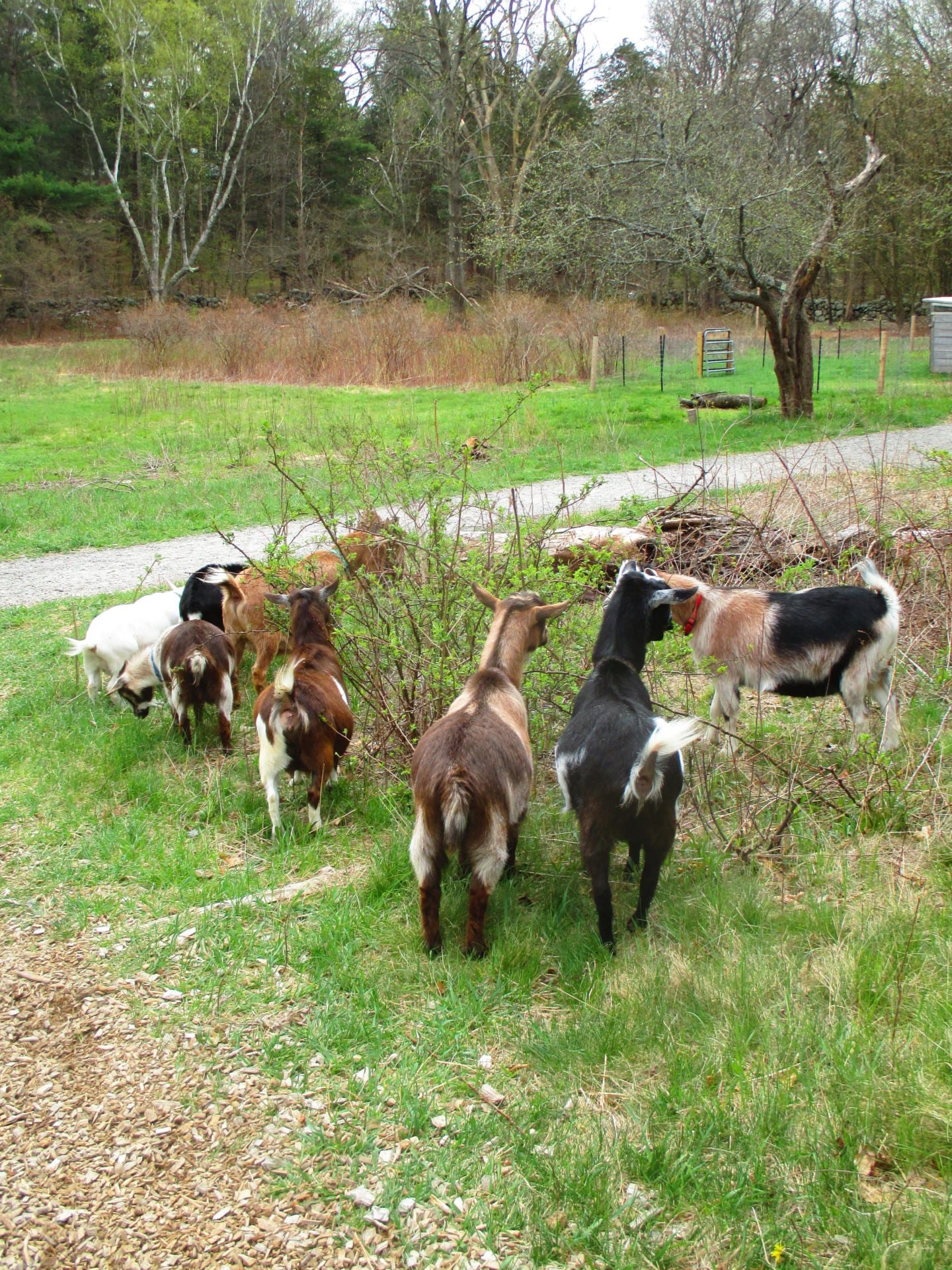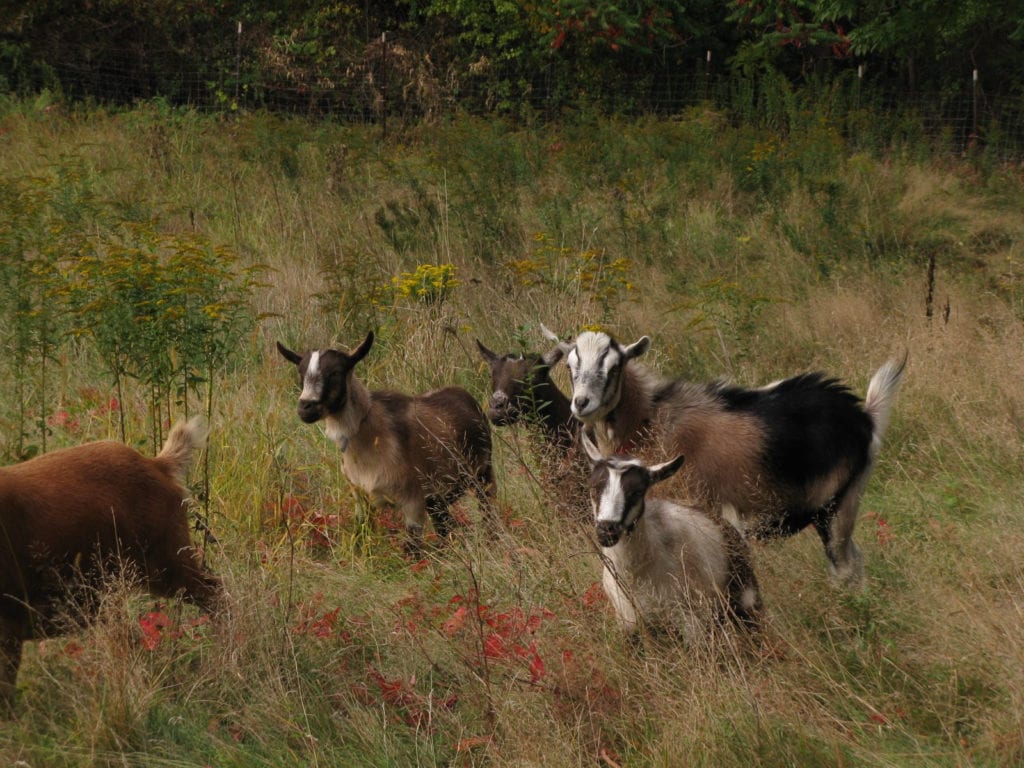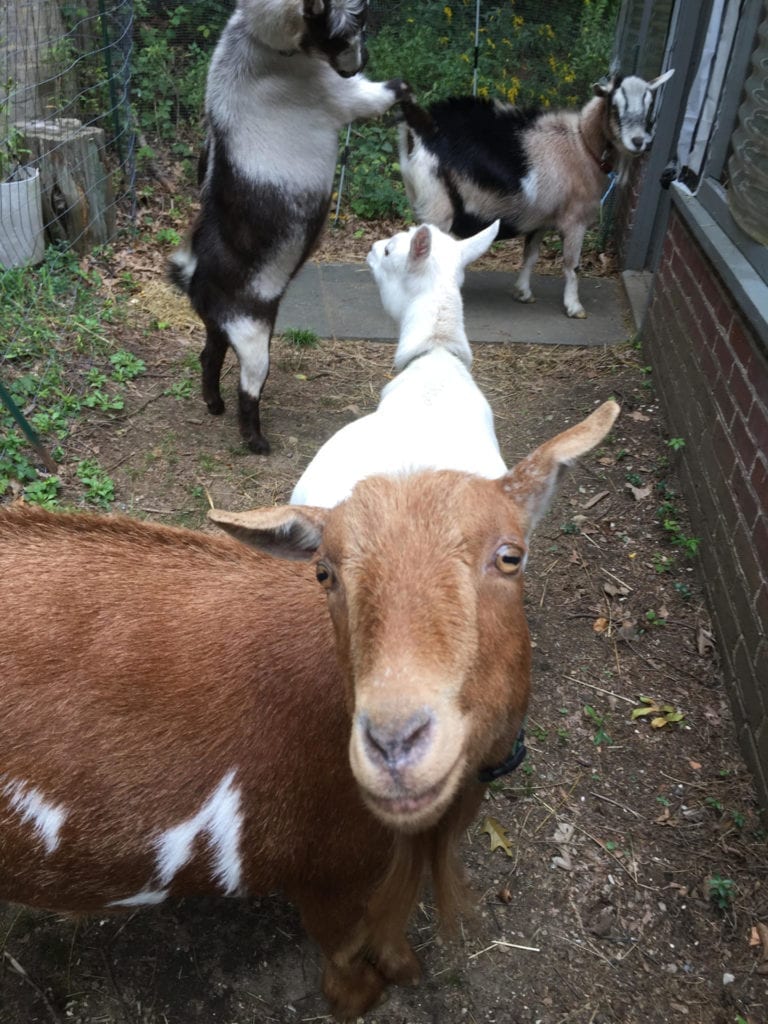by Sandy Vorce
Gotta get a goat. This was my mantra a decade ago while hacking through bittersweet, buckthorn, and multiflora rose in an attempt to reclaim a portion of meadow at Mass Audubon Habitat Education Center and Wildlife Sanctuary in Belmont, MA.
My wish was granted in 2010 when a neighbor, Liz Shaw, approached us with an offer to graze her sheep on a newly acquired three-acre parcel of meadow. I shared with Liz my desire for goats, and she offered to get some goats to supplement the sheep. We petitioned the Belmont Zoning Board of Appeals and received first a temporary and later a permanent permit for the use of domestic sheep and goats for the ecological management of open fields at Habitat.
With the help of friends and some Habitat volunteers Liz set up to target graze the meadow. The results exceeded our expectations. Not only were the meadows cleared of unwanted woody shrubs, and many invasive plants, but native grasses such as little bluestem emerged and flourished.
A Community Welcome
The sheep and goats were fully embraced by neighbors and the greater community. Liz and other local farmers taught us a lot about livestock management and the benefits of targeted and rotational grazing. When Liz moved her sheep to her new farm in New Hampshire we took her up on the offer to keep and care for the goats at Habitat during the growing season so that the herd could continue to browse some of our 15 acres of meadows.
For the first few years, the goats spent their winters in New Hampshire. After a few years of this arrangement, it was suggested that we take on the goats permanently so in 2016 we retrofitted an old unused greenhouse into a winter goat pavilion. With the help of many volunteers we now care for the goats year-round.
Biting into the Job
While the Habitat herd has become a much beloved attraction, it is also part of our Ecological Management Plan. The herd’s job is to mow the meadows in a targeted way that helps control invasive plants while allowing native plants and grasses to flourish. Why are goats so good for invasive plant management? Goats are natural browsers and prefer to eat broad leaved and woody stemmed plants. They happen to love buckthorn, multiflora rose, and bittersweet, which account for most of the invasive plants in the Habitat meadows. When the goats eat the leaves and stems of invasive plants, it allows light and air to get to native plants and grasses, leveling the competitive playing field. Continual re-browsing of some invasive plants may also weaken them through carbohydrate starvation. By eating unwanted woody stems goats also keep the fields from reverting to forest, thereby maintaining a valuable meadow ecosystem.
Goats prefer to eat higher on plants. This is a natural protection against worms and other parasites located closer to the ground. Eating higher means the base of the plants are left in the ground and will likely re-grow without manual removal or treatment. In meadow restoration areas, a group of volunteers will often follow up a recently browsed area with weed wrenches to pull out the remaining invasive plant roots. I can tell you it’s much easier to remove a multiflora rose bush after the goats have eaten off all the thorny stems!
Enjoying a Selective Diet
Goats like variety and are selective in what they eat. They prefer many invasive plants over some of the native plants and grasses in the meadow. I recently watched one of the goats carefully pluck bittersweet leaves and nip at the vine that was wrapped around a goldenrod without disturbing the pollinator covered flowers. The goats also eat poison ivy, a native plant, that grows unwanted on trail edges and program areas. Yes, they do like blueberries and other native shrubs, so we have to keep them away from our wildlife berry patches, except for occasional forays when we let them munch their way to the bushes, removing overgrowth as they go.
Goats do not like the taste of milkweed, which is good for the monarchs. Unfortunately, this also means they don’t like black swallow-wort. They do eat a lot of the plants around black swallow-wort, which makes it easier for us to find and manage this pervasive invasive. For the most part goats self-select what they eat and avoid plants that would harm them. We keep the goats away from plants such as rhododendron that are highly toxic.
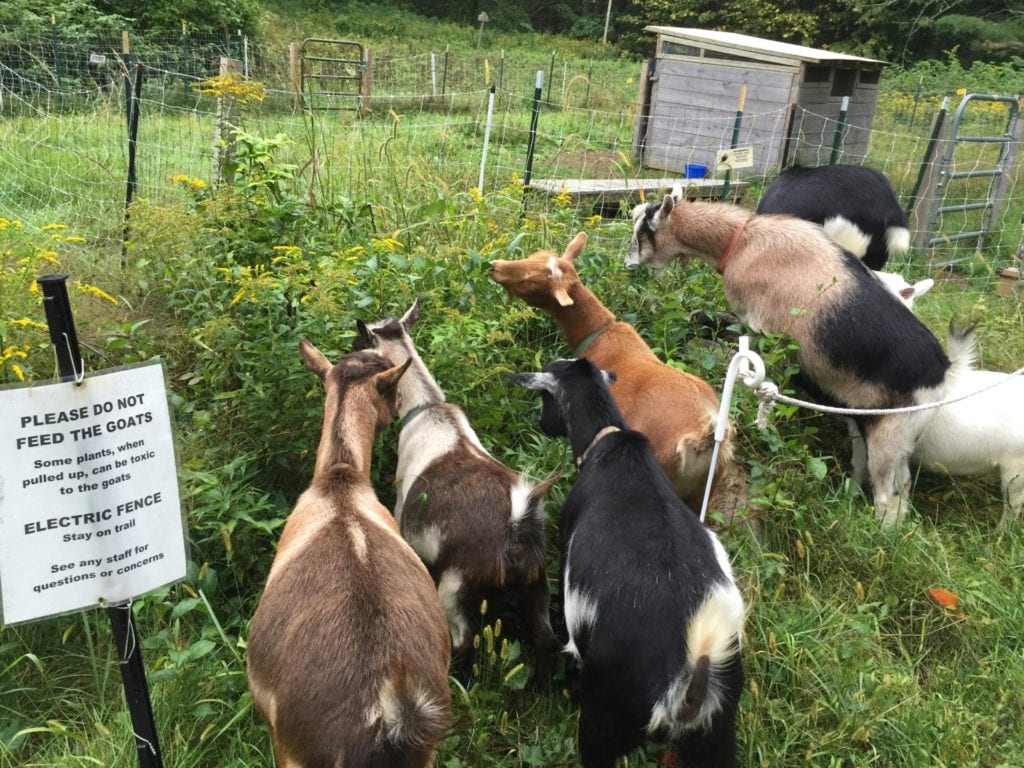
Electro-net fencing encloses the goats in a new browse area where they consume the bittersweet, leaving the goldenrod for the pollinators.
Like many of us who will eat that questionable jar of something in the fridge if there is nothing else to eat, goats left to browse too long in one area will move on from their favorite plants to other less desirable plants. That is one of the reasons rotational grazing is so important. Not only does this method allow each browsed area to recover and native plants and grasses to self-seed, but it is healthier for ruminants such as goats. By moving to a new area every week or two they leave possible intestinal parasites behind, and those parasites cannot survive long without a host. Goats fertilize the fields as they browse, and if we see the need to restore an area, we will throw down some native meadow seed mix a day or two before moving the herd to a new area so their hooves can push the seed into the ground.
Goats are herd animals and tend to stay together. They will follow a group of people who they view as good protection due to our height. We herd our goats to the various meadows during the day and tuck them into wooden goat huts at night. Volunteers shepherd the goats while they are in the fields; they also answer visitor questions and ensure the goats have adequate shade, water, and protection. Because we are a busy Sanctuary, with lots of visitors, classes, and summer camp participants, we use electro-net fencing to enclose the herd in each new browse area. We attach a solar powered battery charger to the electro-net fence to send a current that provides enough of a shock to keep goats in and deter predators. On the quieter off-season days, one of my favorite activities is to walk the goats around the fields for what we call “free-browsing,” which is the way people and goats have wandered the land together for thousands of years.
Intangible Benefits
This is where the cute comes in! Our herd of Nigerian Dwarf Goats is adorable. This breed is small and generally friendly. They each have their own personality, and they are emotionally intelligent. In addition to their meadow mowing job the goats at Habitat also participate in a variety of programs from goat socials to goat education, and the herd self-adjusts their actions to different ages and abilities. Volunteers get trained to be Goat-Tenders, and we have an amazing volunteer community that cares for and cleans up after the herd.
While goats have plenty of free eats in the meadow, there are costs associated with keeping a herd from hay, minerals, tools, fencing, and shelter costs to annual vaccines and veterinary care expenses. Fundraisers and donations are required for our goat program to be self-sustaining. In this area, cute works to our advantage, and the efforts of volunteer-coordinated fundraising continues to keep our four-hoofed maintenance crew happy and health.
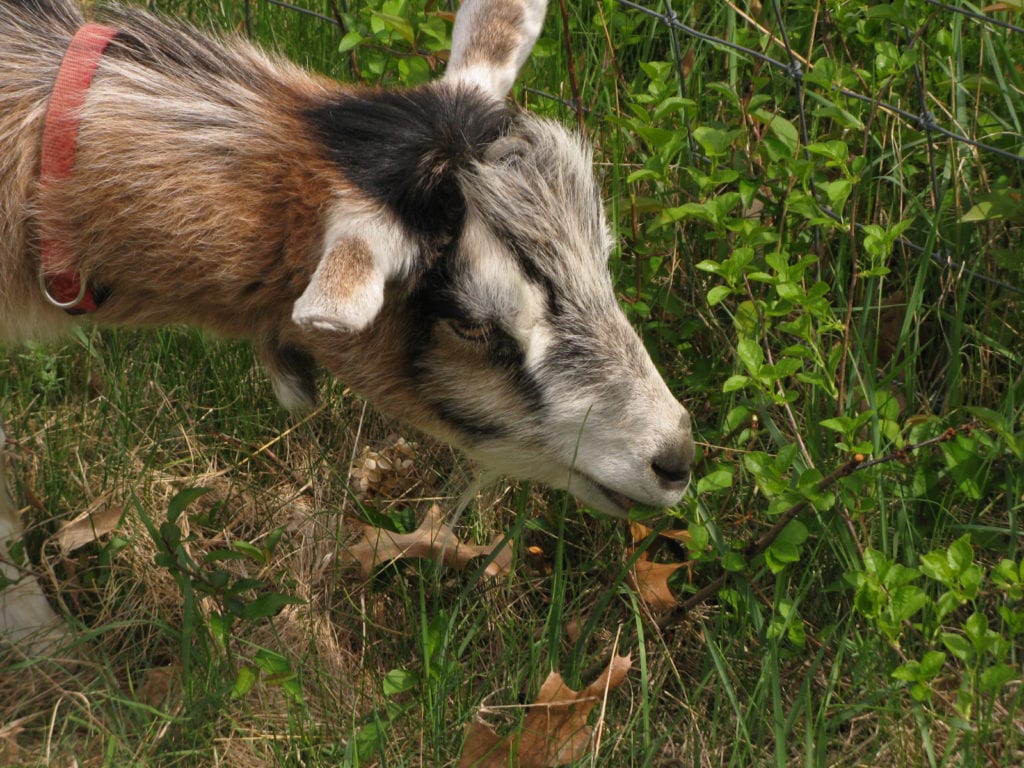
The goats are not only a hardworking, ecologically-focused maintenance crew, but each one is an adorable advocate for the fundraising programs that keep the herd happy and healthy.
Want to learn more? Join Sandy for an Eco-tour in Belmont, MA on September 24: Effective Invasive Plant Management: Chemical-Free & So Darn Cute.
About the Author
Sandy Vorce is a nature enthusiast and works as a Manager at Mass Audubon Habitat Education Center and Wildlife Sanctuary in Belmont, MA. Sandy tends everything from gardens to goats and enjoys working with volunteers of all ages and backgrounds in caring for the property and its inhabitants. She is a former ELA board member and now participates with local Land Trusts and Climate Action groups.
***
Each author appearing herein retains original copyright. Right to reproduce or disseminate all material herein, including to Columbia University Library’s CAUSEWAY Project, is otherwise reserved by ELA. Please contact ELA for permission to reprint.
Mention of products is not intended to constitute endorsement. Opinions expressed in this newsletter article do not necessarily represent those of ELA’s directors, staff, or members.

